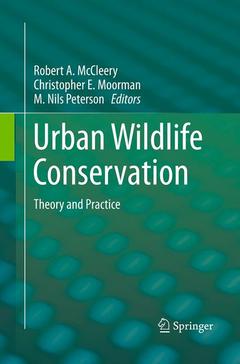Urban Wildlife Conservation, Softcover reprint of the original 1st ed. 2014 Theory and Practice
Coordonnateurs : McCleery Robert A., Moorman Christopher E., Peterson M. Nils

In the past, wildlife living in urban areas were ignored by wildlife professionals and urban planners because cities were perceived as places for people and not for wild animals. Paradoxically, though, many species of wildlife thrive in these built environments. Interactions between humans and wildlife are more frequent in urban areas than any other place on earth and these interactions impact human health, safety and welfare in both positive and negative ways. Although urban wildlife control pest species, pollinate plants and are fun to watch, they also damage property, spread disease and even attack people and pets. In urban areas, the combination of dense human populations, buildings, impermeable surfaces, introduced vegetation, and high concentrations of food, water and pollution alter wildlife populations and communities in ways unseen in more natural environments. For these ecological and practical reasons, researchers and mangers have shown a growing interest in urban wildlife ecology and management.
This growing interest in urban wildlife has inspired many studies on the subject that have yet to be synthesized in a cohesive narrative. Urban Wildlife: Theory and Practice fills this void by synthesizing the latest ecological and social knowledge in the subject area into an interdisciplinary and practical text. This volume provides a foundation for the future growth and understanding of urban wildlife ecology and management by:
? Clearly defining th
e concepts used to study and describe urban wildlife,? Offering a cohesive understanding of the coupled natural and social drivers that shape urban wildlife ecology,
? Presenting the patterns and processes of wildlife response to an urbanizing world and explaining the mechanisms behind them and
? Proposing means to create physical and social environments that are mutually beneficial for both humans and wildlife.
1. Introduction.- 2. History of Urban Wildlife Science.- 3. Urban Wildlife Science in Coupled Human-Natural Systems.- 4. Abiotic Drivers of Ecological Structure and Function in Urban Systems.- 5. Drivers of Vegetation Species Diversity and Composition in Urban Ecosystems.- 6. The Urban Ecosystem: Social Drivers.- 7. Wildlife Responses to Urbanization: Patterns of Diversity and Community Structure in Built Environments.- 8. Wildlife Population Dynamics in Urban Landscapes.- 9. Urban Wildlife Behavior.- 10. Infectious Disease and Contaminants in Urban Wildlife: Unseen and Often Overlooked Threats.- 11. Urban Wildlife Communication and Negotiation.- 12. Integrating Wildlife Conservation into Urban Planning.- 13. Conservation Development: Designing and Managing Residential Landscapes for Wildlife.- 14. Managing Urban Wildlife Habitat at the Local Scale.- 15. Wildlife Friendly Roads: The Impacts of Roads on Wildlife in Urban Areas and Potential Remedies.- 16. Managing Aquatic Environments for Wildlife in Urban Areas.- 17. Wildlife Damage Management in the Urban Landscape.
Robert (Bob) McCleery is an Assistant Professor in the department of Wildlife Ecology and Conservation Biology at the University of Florida. His research focuses include understanding how wildlife responds to anthropogenic changes to their environment and finding ways to maintain wildlife communities and populations that foster healthy ecosystems. Much of Bob’s work has been centered on mammalian conservation in urbanizing and agricultural landscapes. Bob received his B.S. from Cornell University and M.S. and Ph.D. degrees from Texas A&M University.
Nils Peterson is an Associate Professor of Fisheries, Wildlife, and Conservation Biology at North Carolina State University. His research focuses on unravelling the drivers of environmental behavior, using environmental education, conservation development, environmental conflict and environmental policy-making as natural experiments to test hypotheses. Much of this research is summarized in his recent book The Housing Bomb. Nils received his B.S. and M.S. degrees from Texas A&M University and his Ph.D. from Michigan State University.
Chris Moorman is Professor and Coordinator of the Fisheries, Wildlife and Conservation Biology Program at North Carolina State University (NCSU). His research focuses on global change and wildlife with emphasis on understanding the effects of human-induced landscape change on wildlife habitat. Chris developed the course Urban Wildlife Management at NCSU, published a four-
part extension publication series on backyard and urban wildlife management and led collaborative efforts to create the Going Native website, an interactive resource for those interested in landscaping for wildlife with native plants. Chris received his B.S. and M.S. degrees from the University of Georgia and his Ph.D. from Clemson University.Emphasizes specific practices that can be used to create built environments that are wildlife friendly
Focuses on mechanisms for the patterns and processes of wildlife ecology in urban environments
In addition to human dimensions, the book will cover ecological theory, the behavior and physiology of urban wildlife and the planning and management of wildlife friendly developments
Includes supplementary material: sn.pub/extras
Date de parution : 09-2016
Ouvrage de 406 p.
15.5x23.5 cm
Date de parution : 11-2014
Ouvrage de 406 p.
15.5x23.5 cm



